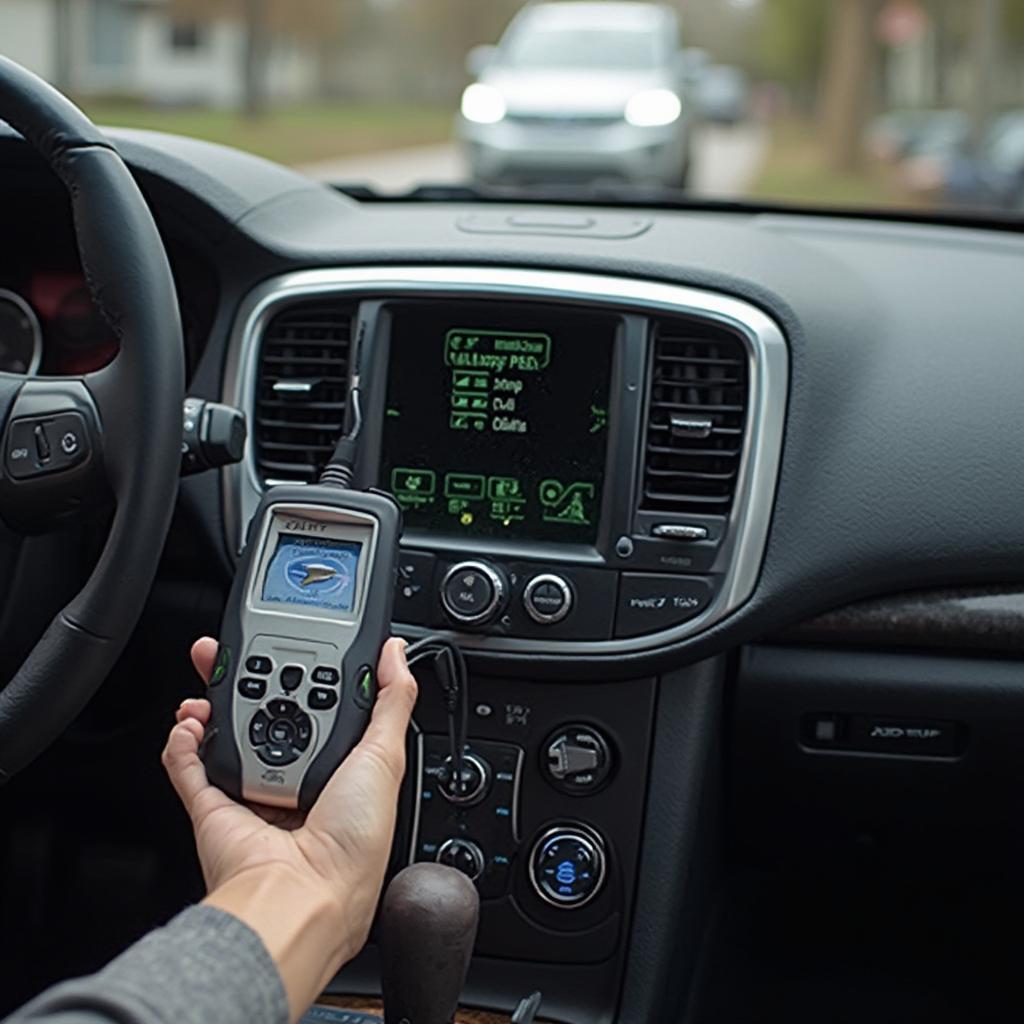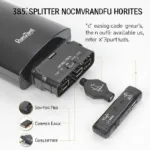Owning a Volvo S80 is a dream, but even the best cars can have issues. Thankfully, the OBD2 port makes diagnosing and sometimes even fixing those problems easier. This guide will walk you through using an OBD2 scanner on your Volvo S80.
Understanding Your Volvo S80 and OBD2
The OBD2 port, often called the diagnostic port, is a standardized interface for accessing your car’s onboard computer. Think of it like a window into your car’s health. By connecting an OBD2 scanner, you can read diagnostic trouble codes (DTCs), monitor engine performance, and much more.
Locating the OBD2 Port on Your Volvo S80
The OBD2 port in most Volvo S80 models is usually located beneath the driver’s side dashboard, near the pedals. It’s a trapezoidal-shaped connector with 16 pins.
 OBD2 Scanner Connected to Volvo S80
OBD2 Scanner Connected to Volvo S80
Choosing the Right OBD2 Scanner
Not all OBD2 scanners are created equal. For basic code reading, a simple code reader will suffice. However, for more advanced features like live data streaming and component activation, you’ll need a more sophisticated scanner.
Here are some factors to consider when choosing an OBD2 scanner:
- Compatibility: Ensure the scanner is compatible with your Volvo S80’s model year.
- Features: Determine the features you need, such as code reading, live data streaming, and bi-directional control.
- Ease of use: Look for a scanner with a user-friendly interface and clear instructions.
- Price: OBD2 scanners range in price, so set a budget and find one that meets your needs and budget.
Connecting the OBD2 Scanner to Your Volvo S80
- Locate the OBD2 port.
- Turn the ignition to the “on” position. Don’t start the engine.
- Connect the OBD2 scanner to the port. You should hear a click when it’s securely connected.
- Turn on the scanner. The scanner will typically power on automatically when connected to the vehicle’s OBD2 port.
Reading and Interpreting Diagnostic Trouble Codes (DTCs)
Once connected, the OBD2 scanner can read any stored DTCs:
- Select “Read Codes” on the scanner.
- The scanner will display any stored codes.
- Write down the codes.
DTCs are alphanumeric codes that indicate specific problems with your vehicle. For example, a “P0301” code indicates a misfire in cylinder 1. You can use online resources like OBDFree to look up the meaning of specific DTCs and get information on potential causes and fixes.
"It's important to note that OBD2 codes provide a starting point for diagnosis," says automotive electronics expert John Miller. "Don't automatically assume you need to replace a part based solely on a code. Further inspection is often needed."Clearing DTCs
After addressing the underlying issue that triggered a DTC, you can use the OBD2 scanner to clear the code from your car’s computer:
- Select “Clear Codes” on the scanner.
- Confirm the action on the scanner.
- Verify that the code has been cleared.
Beyond Code Reading: Advanced OBD2 Features
Advanced OBD2 scanners offer features beyond basic code reading:
-
Live Data Streaming: View real-time data from your car’s sensors, such as engine RPM, coolant temperature, and oxygen sensor readings.
-
Component Activation: Test certain components, such as activating the fuel pump or ABS system.
“Advanced features allow for more in-depth troubleshooting,” adds Miller. “However, these features require a deeper understanding of automotive systems and should be used with caution.”
Conclusion
Understanding how to use an OBD2 scanner on your Volvo S80 empowers you to take control of your car’s maintenance. Whether you’re a DIY enthusiast or just want to be more informed when talking to a mechanic, an OBD2 scanner is a valuable tool for any Volvo S80 owner. Remember, while OBD2 scanners are powerful tools, they’re just one part of proper car maintenance. Always consult your owner’s manual and seek professional help if you’re ever unsure about something.
